Ten remarkable new marine species from 2023
EMBARGO: 00:01 GMT March 19th, 2024
- Falkor’s Carnivorous Sponge, Abyssocladia falkor
- The Bifrost Nemertean, Tetranemertes bifrost
- Solwarawarriors Vestimentiferan, Alaysia solwarawarriors
- Hannan’s Pygmy Squid, Kodama jujutsu
- The Samoan Nautilus, Nautilus samoaensis
- Prince Albert’s Sea Daisy, Xyloplax princealberti
- Bouchet’s Dorymenia, Dorymenia boucheti
- Fine Line Nudibranch, Halgerda scripta
- Fordyce’s Giant Penguin, Kumimanu fordycei †
- St. George's Cross Medusa, Santjordia pagesi
Falkor’s Carnivorous Sponge
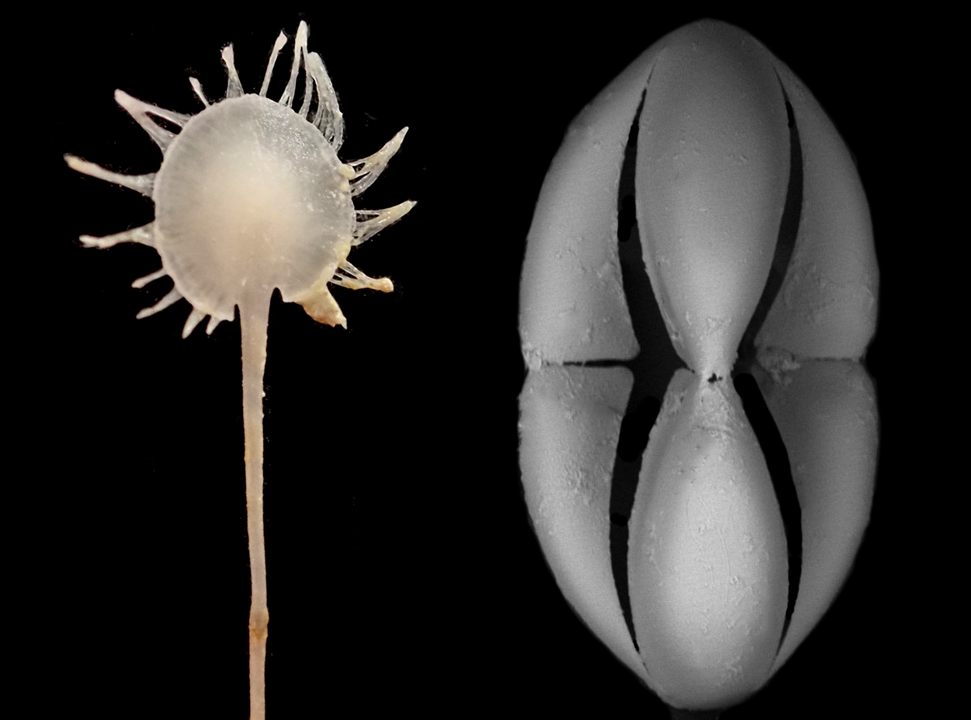
Abyssocladia falkor Ekins & Hooper, 2023
The deep sea is a food desert, with relatively limited sources of nutrition. Scarcity of food resources has led to innovation in the denizens of the deep: the deep-sea sponge Abyssocladia falkor Ekins & Hooper 2023 is a carnivore, using hook shaped spicules to hold small crustaceans in place while its cells engulf them. The evolution of carnivory in sponges is interpreted to be a response to the more limited availability of particulate matter at depth, and it has led to a radiation within the poriferan family Cladorhizidae. The discovery of carnivory in sponges was one of the big surprises from recent decades of documentation of biodiversity in the deep sea. R/V Falkor, honored for its role in the collection of A. falkor, is one of the many research vessels that have made the biodiversity and ecology of the deep sea more accessible.
The Bifrost Nemertean
Tetranemertes bifrost Cherneva, Ellison, Zattara, Norenburg, Schwartz, Junoy & Maslakova, 2023
https://marinespecies.org/aphia.php?p=taxdetails&id=1739517
The Bifrost Nemertean is a long and threadlike, beautifully colored marine worm from the Caribbean that can reach lengths over 20 cm (8 in). Nemerteans, also known as ribbon worms, are a group of aquatic worms with an eversible proboscis that they can hydrostatically shoot forward to capture animal prey. The Bifrost Nemertean’s vibrant coloration includes stripes and spots of blue, green, yellow or orange, on a background of black to purple, depending on the individual and lighting. The authors of this new species note that The Bifrost Nemertean is likely the most spectacularly colored nemertean in the Caribbean, if not the whole world. The bright coloration likely serves as a warning to potential predators, as ribbon worms produce diverse toxins used both for predation and defense. Some of the ribbon worm toxins have been investigated for a role in treating of Alzheimer’s disease and schizophrenia.
Its species name “bifrost” refers to its iridescent stripes and spots and is a reference to Bifröst, the rainbow bridge in Norse mythology that reaches between Midgard, the human Earth, and Asgard, the realm of the gods, which may be recognizable to fans of the popular God of War video game franchise. Bifröst means “shimmering path” or “the swaying road to heaven” and some think it was inspired by views of the Milky Way in the night sky.
This nemertean usually lives in shallow subtidal coral rubble, gravel, and shell hash and can sometimes be found stretched between nooks and crannies on the sea floor. In the 1970s, some 50 years before this new species was described, Smithsonian photographer Kjell Sandved took a photograph of this colorful animal on a fan coral in Puerto Rico.
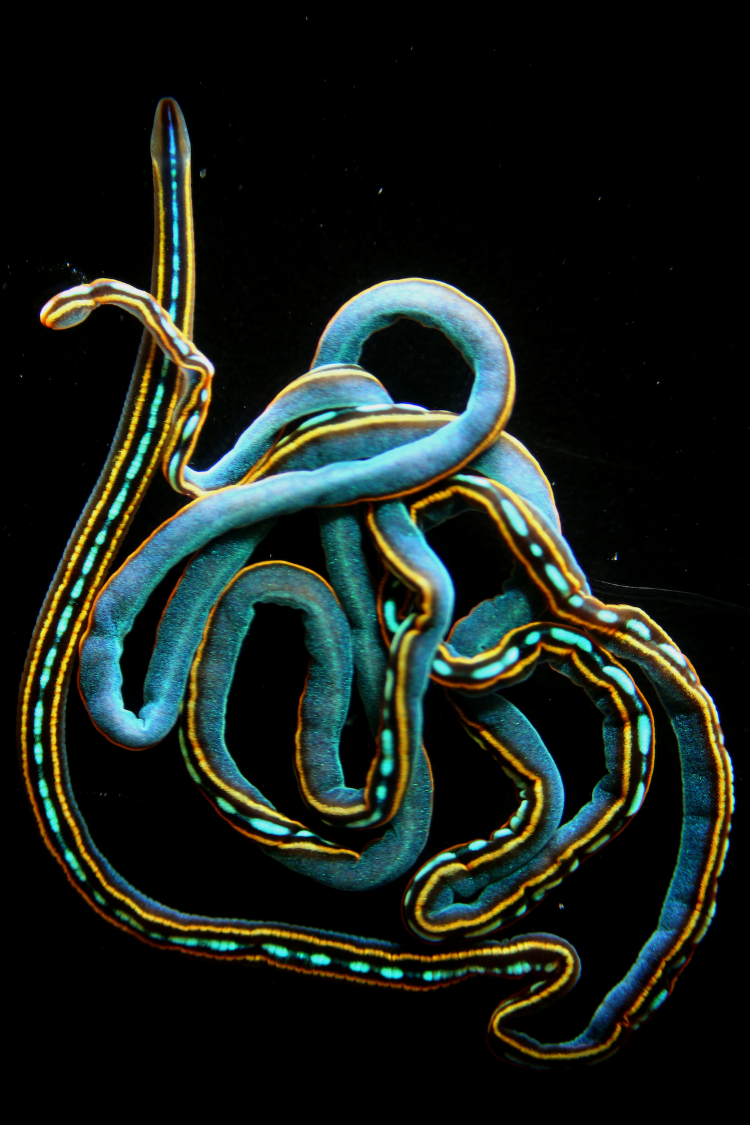
Solwarawarriors Vestimentiferan
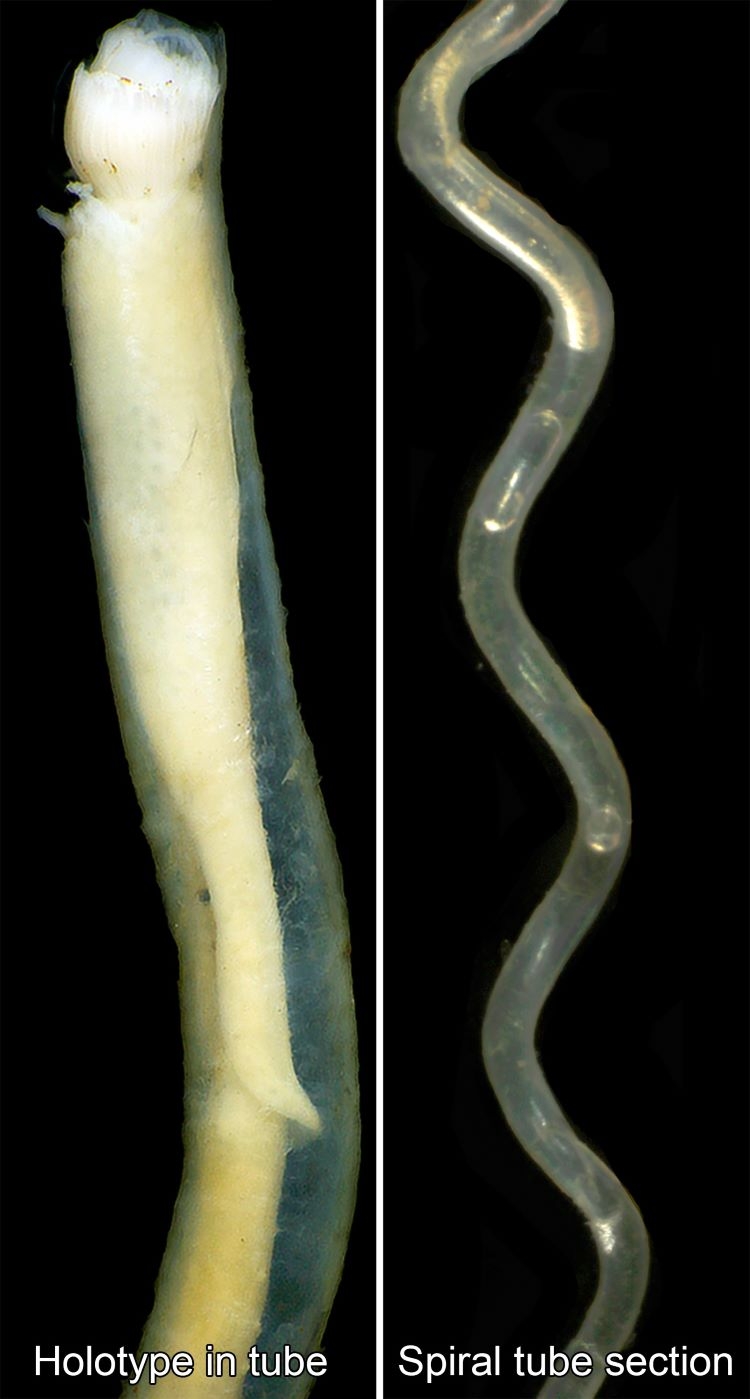
Alaysia solwarawarriors McCowin, Collins & Rouse, 2023
https://marinespecies.org/aphia.php?p=taxdetails&id=1697811
The unique biota of the deep sea deserves protection. Luckily, groups like the Alliance of Solwara Warriors, a coalition of communities from Papua New Guinea, and islands in the Solomon and Bismarck Sea, are working to protect deep sea ecosystems and the cultural and environmental heritage of people in the region through advocacy, education, and partnership. The efforts of the Solwara Warriors have been commemorated in the name of Alaysia solwarawarriors McCowin, Collins & Rouse 2023, a new species of vestimentiferan worm described from hydrothermal vent fields in the Manus Basin of the Bismarck Sea. Like the Solwara Warriors for which they are named, A. solwarawarriors is an integral part of its community, playing an anchoring role in their hydrothermal ecosystems by providing three-dimensional structure and food around which a diverse community assembles.
Hannan’s Pygmy Squid
Kodama jujutsu A. Reid, N. Sato, Jolly & Strugnell, 2023
https://marinespecies.org/aphia.php?p=taxdetails&id=1716239
Tiny, nocturnal and less than a centimeter in length, Kodama jujutsu Reid, Sato, Jolly & Strugnell 2023 nonetheless has an undeniable propensity for the limelight. These pygmy squid made themselves known to recreational divers by swimming towards the light of dive torches and then striking a pose, with the arms and tentacles held out in a circle. Further study by scientists determined that these tiny beauties represent not just a new species but a new genus, distinctive among pygmy squid for their body shape and reproductive morphology. Beyond their anatomical distinctiveness, K. jujutsu shows some unusual biological interactions, using moves that recall its namesake martial art to capture shrimp and declining to disengage from hydrozoans that are being eaten by nudibranchs. Because of their affinity for dive torches and for coral, nudibranchs, and other high-interest marine creatures, dive enthusiasts have been helpful in documenting the biology and occurrence of K. jujutsu. However, the coral reefs they inhabit are vulnerable to climate change and other human impacts. Acknowledging that knowledge of the beauty, charisma, and importance of biodiversity can serve a protective function for habitats, Reid and colleagues chose the name Kodama for the new genus described for this species, hoping that this new squid will serve the guardian role of Kodama, protective spirits of the nature in Japanese folklore.
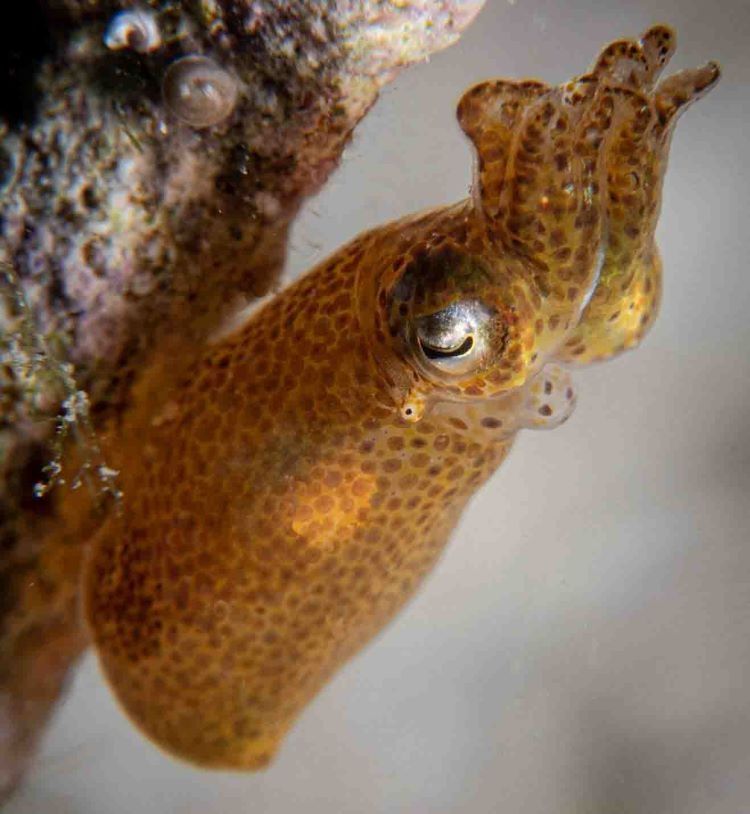
The Samoan Nautilus
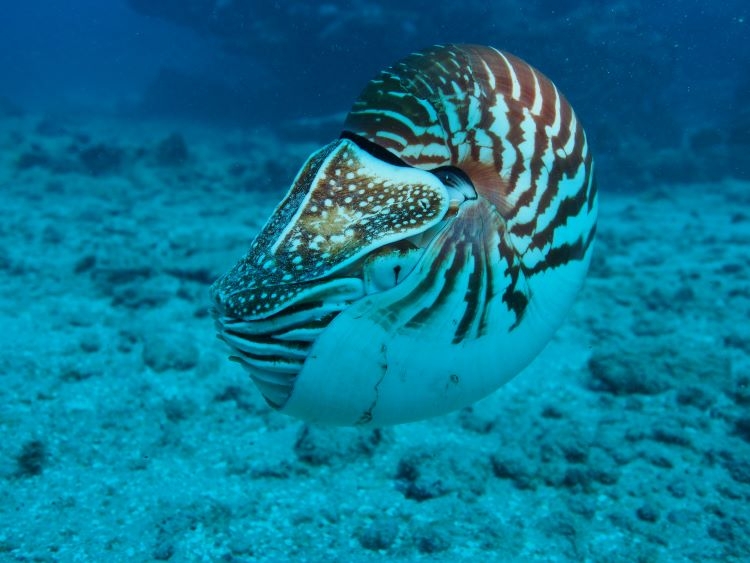
Nautilus samoaensis Barord, Combosch, Giribet, Landman, Lemer, Veloso & Ward, 2023
https://marinespecies.org/aphia.php?p=taxdetails&id=1632880
The Samoan Nautilus is one of three new species of Nautilus described in 2023, which doubled the number of known species from three to six. The Samoan Nautilus is named after the islands near which it was discovered. Of all six species of Nautilus, the Samoan Nautilus has one of the prettiest and most distinctive color patterns on its beautiful shell, which includes multiple branching stripes that have a rearward projection. It lives near Pago Pago, American Samoa, where it has been found at depths between 200 and 400 m.
To collect nautiluses for science, the researchers created traps out of steel and chicken wire, baited them with chicken, and deployed the traps to depths of about 300 meters on the ocean floor. Fishing rope up to a surface buoy marks the location of each trap. After 12 hours, the traps are reeled in by hand. “Eventually, you see the trap and these white little orbs in it and you know you’ve caught some nautiluses,” says Dr. Barord, one of the authors of the study. Then, “one of us jumps in the water and free dives about 5 meters to carefully reach for the nautiluses in the trap and bring them to the surface. You are face to face with these uniquely, misunderstood organisms,” Barord says. To learn even more about nautiluses, their team also deploys baited remote underwater video systems (BRUVS) to record nautiluses, and other species, in their natural environment, tracks their migrational patterns by affixing radio transmitters to their shells, and collects non-lethal tissue and shell samples to better understand their evolutionary relationships and where they fit in the food chain.
Unfortunately, nautiluses may be under threat from human impact including ocean acidification, eutrophication, and warming seas. They are particularly threatened by overfishing from the shell trade, where millions are caught and killed, not to eat, but just to sell their beautiful shells. Barord says the research, “started with simply counting how many nautiluses were left in different areas across the Indo-Pacific, then recording them in their natural habitat, then tracking their migrations, and now describing new species.” He goes on to say, “This is certainly an exciting time for nautilus research, as we uncover more and more information about the secret life of nautiluses. I just hope that this is also an exciting time for nautiluses as well, and they continue doing their nautilus thing as they have done for millions of years.”
Prince Albert’s Sea Daisy
Xyloplax princealberti Payne, Tilic, Boschen-Rose, Gannon, Stiller, Hiley, Grupe, Mah & Rouse, 2023
https://marinespecies.org/aphia.php?p=taxdetails&id=1722498
At first glance, you would be hard-pressed to recognize this 1 cm circular organism as a sea star (or starfish, depending on your preference). This new species is just one of four known species of Xyloplax, which are also called sea daisies for their delicate, flower-shaped appearance. They are so unusual that prior to genetic sequencing of this new species, they were thought to be their own class of echinoderms rather than a fascinating and unique branch of the sea star tree of life. Until now, sea daisies were only known attached to sunken wood in the deep sea, which they presumably feed on. But this new species is making us rethink everything we know about sea daisies.
In addition to living on sunken wood, Prince Albert’s Sea Daisy, Xyloplax princealberti, can be found on hydrothermal vent tubeworms (Ridgeia piscesae) along the eastern Pacific from Canada to Costa Rica. Unlike all other species of Xyloplax, Prince Albert’s Sea Daisy is hermaphroditic, having both male and female reproductive abilities, which is a major advantage when trying to find a suitable mate in the dark ocean depths. The species name honors His Serene Highness Prince Albert II of Monaco, for his support of marine conservation through the Prince Albert II of Monaco Foundation. It is one more example of the many surprises waiting to be discovered in the deep sea and how they are leading us to rethink what we know about the evolution of life on earth.
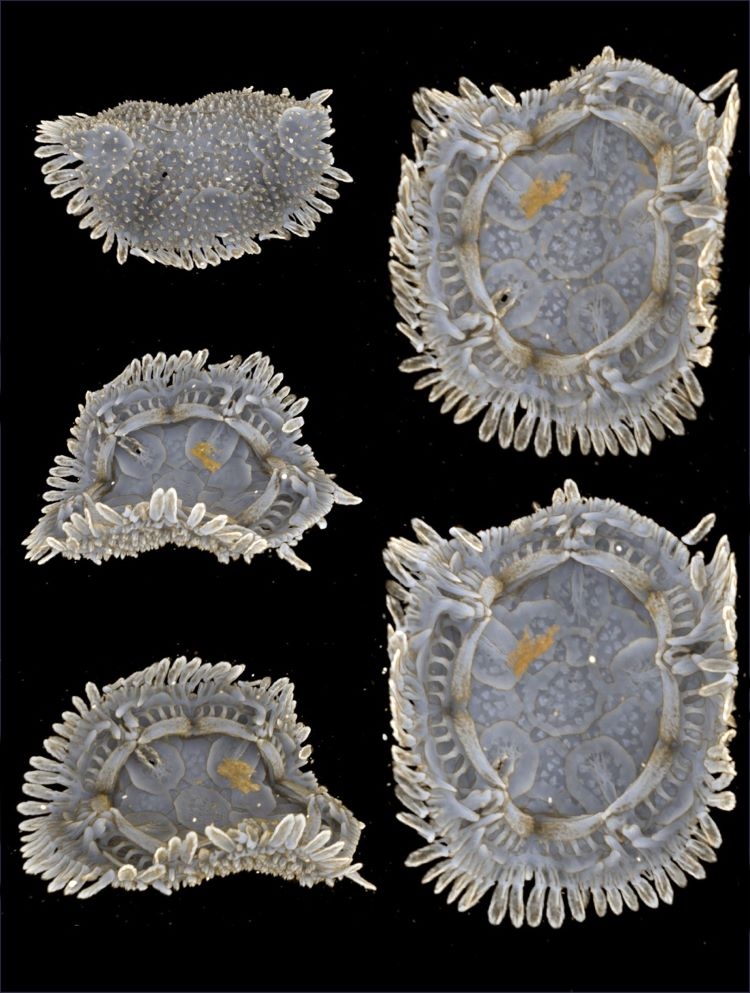
Bouchet’s Dorymenia
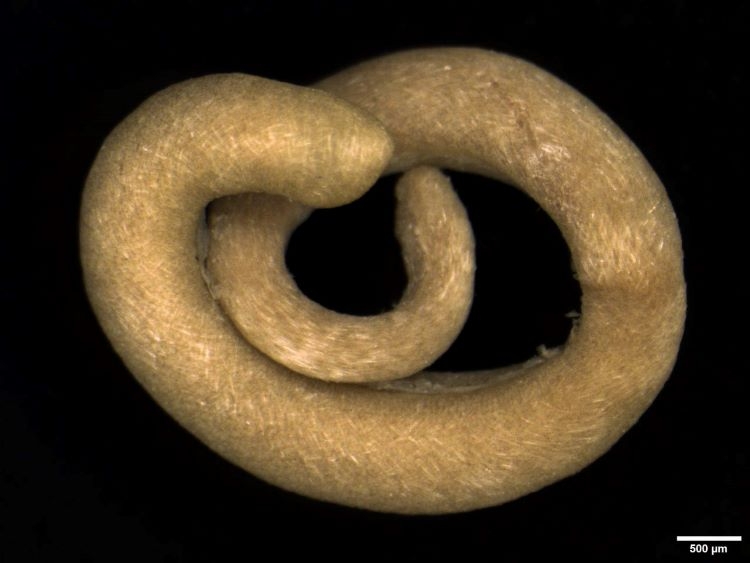
Dorymenia boucheti Cobo & Kocot 2023
https://marinespecies.org/aphia.php?p=taxdetails&id=1664158
Aplacophoran molluscs are worm-like, with elongate bodies covered by spiny spicules rather than a single or paired shell. Historically understudied because of their mostly small size and propensity towards hard-to-sample habitats like the deep sea sediments, the diversity of this group is slowly becoming more clear, as innovative techniques for surveying deep sea habitats, imaging, and genetic assessment make it easier to find and document aplacophorans. A notable recent addition to this group is Dorymenia boucheti Cobo & Kocot 2023, a new species named in honor of Prof. Phillipe Bouchet, expert on the diversity and evolution of Molluscs and a leader in the documentation of marine biodiversity. The identification of Dorymenia boucheti leveraged diverse and detailed data, including gene sequences, microscopic internal anatomy, and scanning electron microscopy of the spines and mouth parts. Taken together, these data highlighted the distinctiveness of D. boucheti among other specimens attributed to Dorymenia and point to novel groupings of genera of Aplacophora. Watch this space for 2024: the analyses that accompanied the description of D. boucheti include multiple samples that cannot be affiliated with existing species, making it highly likely that the coming year will bring more exciting new discoveries in this lineage!
Fine Line Nudibranch
Halgerda scripta Donohoo & Gosliner, 2023
https://marinespecies.org/aphia.php?p=taxdetails&id=1666844
The stark, black-and-white patterning of Halgerda scripta Donohoo & Gosliner, 2023 serves as a warning to predators in the dusky waters of the mesophotic zone, who quickly learn to identify this captivating new species and pass on it as a prey item. Most members of the larger group to which H. scripta belongs are found in bright, shallow waters of the Indo-West Pacific Ocean. All known species of Halgerda in the mesophotic zone stem from a single evolutionary radiation into this habitat. Among the changes seen during this adaptive radiation into deeper waters is a change in coloration to emphasize black-and-white patterns, which are easier to distinguish than colors in darker waters and thus better protect H. scripta and its mesophotic relatives from predators by advertising their nasty taste. The bold lines of H. scripta and its kin underscore long-underappreciated ways in which the subtleties of habitat in marine systems shape biodiversity. Knowledge of species across depth and habitat gradients is key to understanding the evolutionary pressures that shape biodiversity, to understanding biological interactions among habitats, and to protecting the species living in them.
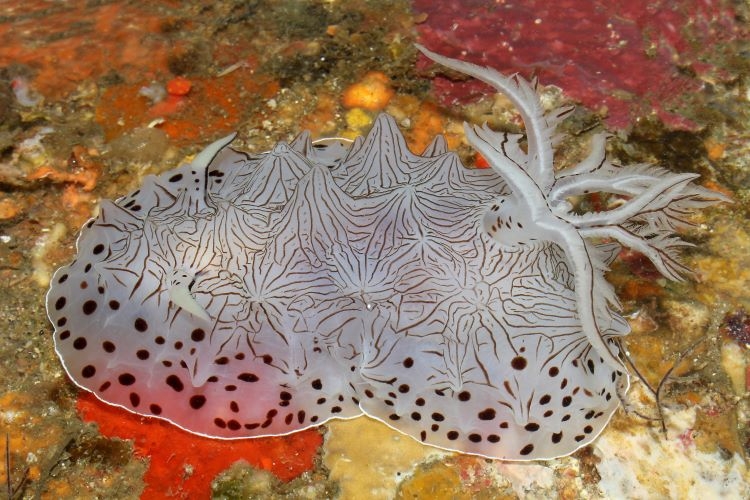
Fordyce’s Giant Penguin
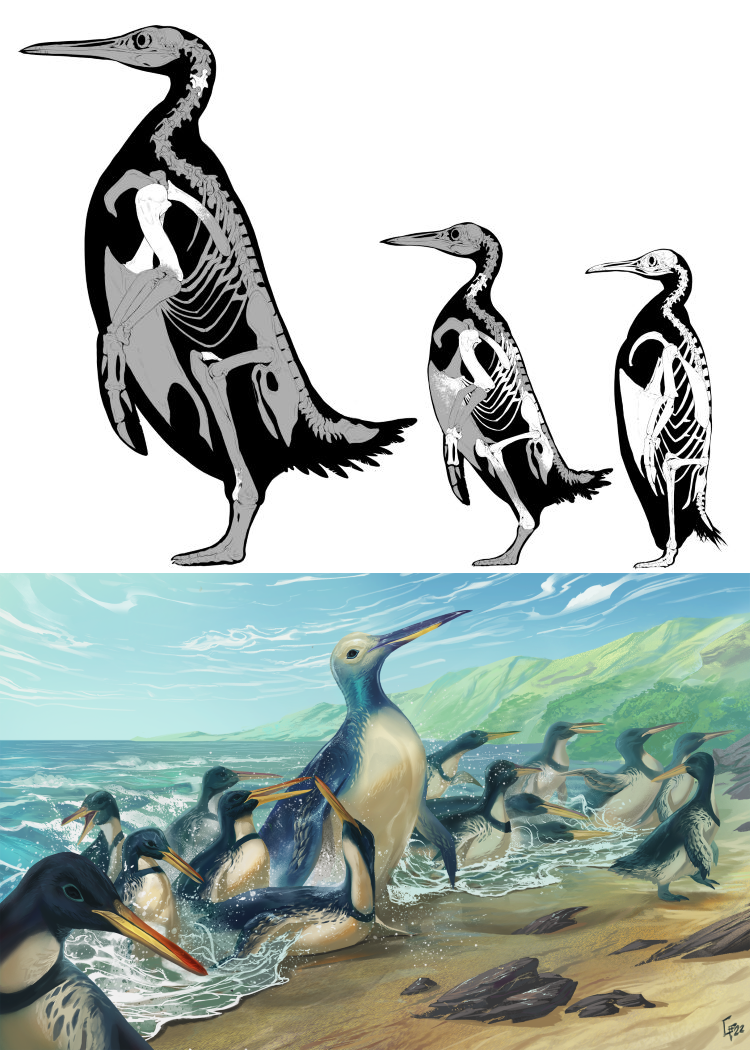
Kumimanu fordycei Ksepka, Field, Heath, Pett, Thomas, Giovanardi & Tennyson, 2023 †
https://marinespecies.org/aphia.php?p=taxdetails&id=1733898
Kumimanu fordycei, Fordyces's giant penguin, appears to be the largest penguin ever discovered. The biggest penguins alive today are emperor penguins, which range from 22–45 kg (50-100 lbs) and stand about 90 cm tall (3 ft). 60 million years ago, Kumimanu fordycei is estimated to have weighed approximately 150 kg (330 lbs)! It is difficult to estimate this species standing height without a complete skeleton, but it is clear they would have towered over modern penguins.
Their giant size may have given these penguins several advantages. Larger animals can maintain their body temperature more easily, which is particularly important for warm-blooded (endothermic) animals like birds and mammals. These massive penguins may have been able to dive deeper, swim further, and perhaps hold their breath longer than other penguins, which means they might have hunted larger prey in colder and deeper waters. It isn’t clear why Kumimanu fordycei and other giant penguins went extinct, but by 20 million years ago the giant penguins had all vanished. One hypothesis is that seals and sea lions, either by predation or competition for food and breeding sites, may have caused the extinction of very large penguin species while smaller penguins survived to the present day.
St. George's Cross Medusa
Santjordia pagesi Lindsay, Grossmann, Montenegro & Morandini, 2023
https://marinespecies.org/aphia.php?p=taxdetails&id=1719587
St. George's Cross Medusa is a large, 10 cm (4 in) colorful new species of jellyfish that gets its name from its bright red cross-shaped stomach. It was first discovered and collected in 2002 by a remotely operated vehicle (ROV) during a dive to about 800 m in the Sumisu Caldera, a sunken volcano off the Ogasawara Islands in Japan. It was not seen again for nearly 20 years when another individual was captured by an ROV in the very same caldera.
After spotting this unique jellyfish for the second time in 2020, it was captured and brought back to the lab for closer study. Morphological and genetic analyses show that it not only represents a new species and new genus, but also an entirely new subfamily! It has many different characteristics from other jellyfish, including the structure of its nearly 240 tentacles that occur under rather than at the rim of the bell.
This jellyfish is so far known only from a single deep-sea volcanic caldera off Japan that contains mineral reserves. It likely has a polyp stage that attaches to the sea floor, although this is yet to be discovered. This might be the only place in the world where this jellyfish lives. Deep sea mining in the area could threaten this new species, as it may hundreds of others that rely on this unique habitat.
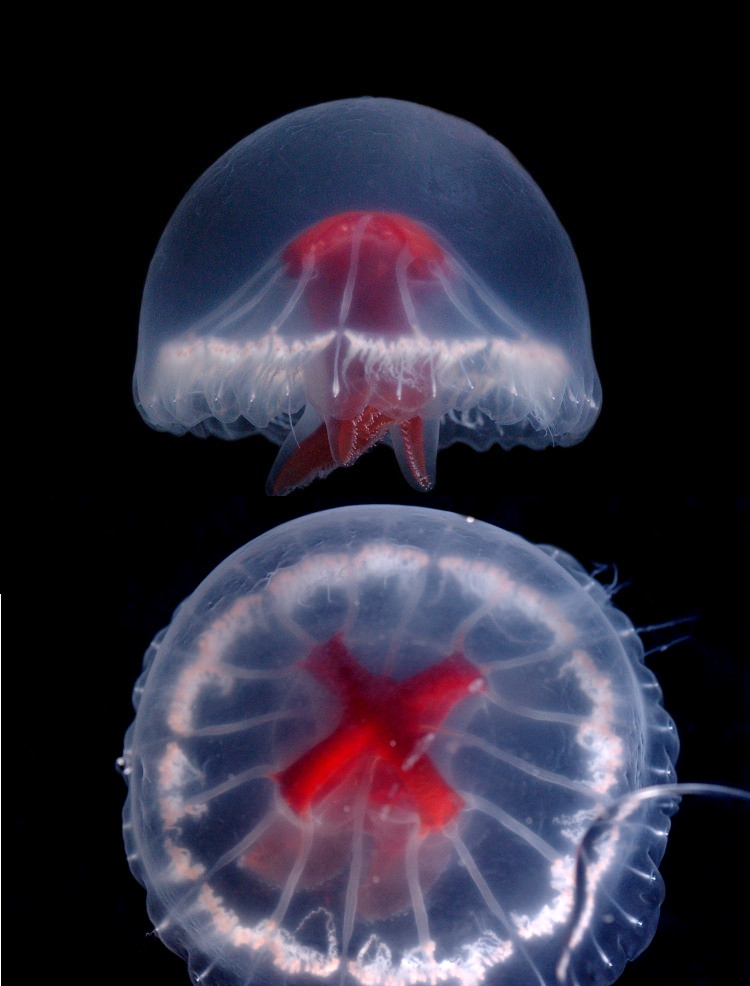
Sources
Falkor’s Carnivorous Sponge
Original source
Ekins, M.; Hooper, J.N.A. (2023). New carnivorous sponges from the Great Barrier Reef, Queensland, Australia collected by ROV from the RV FALKOR. Zootaxa. 5293 (3): 435-471., available online at https://doi.org/10.11646/zootaxa.5293.3.2
Contacts:
Merrick Ekins (merrick.ekins@qm.qld.gov.au), co-author of the new species
John Hooper (john.hooper@qm.qld.gov.au), co-author of the new species
Image available at:
https://marinespecies.org/aphia.php?p=taxdetails&id=1666703#images
Other media:
Marine Biologists Discover Three New Species of Carnivorous Sponges (Sci.News)
Deep sea dive from a desk uncovers three new species (Phys.org)
‘Alien wanderer’ found hanging upside down in underwater cave. It’s a new species (Miami Herald)
The Bifrost Nemertean
Original source:
Cherneva, I.; Ellison, C. I.; Zattara, E. E.; Norenburg, J. L.; Schwartz, M. L.; Junoy, J.; Maslakova, S. A. (2023). Seven new species of Tetranemertes Chernyshev, 1992 (Monostilifera, Hoplonemertea, Nemertea) from the Caribbean Sea, western Pacific, and Arabian Sea, and revision of the genus. ZooKeys. 1181: 167-200., available online at https://doi.org/10.3897/zookeys.1181.109521
Contact:
Svetlana A. Maslakova (svetlana@uoregon.edu), co-author of the new species
Image available at:
https://marinespecies.org/aphia.php?p=image&pic=168520&tid=1739517
More images available at:
https://www.marinespecies.org/aphia.php?p=taxdetails&id=1739517#images
Solwarawarriors Vestimentiferan
Original source:
McCowin, Marina F.; Collins, Patrick C.; Rouse, Greg W. (2023). Updated phylogeny of Vestimentifera (Siboglinidae, Polychaeta, Annelida) based on mitochondrial genomes, with a new species. Molecular Phylogenetics and Evolution. 187; 107872: 1-16., available online at https://www.sciencedirect.com/science/article/pii/S1055790323001720
Contact:
Marina McCowin (marruda@ucsd.edu), co-author of the new species
Patrick Collins (Patrick.Collins@qub.ac.uk), co-author of the new species
Gregory Rouse (grouse@ucsd.edu), co-author of the new species
Image available at:
https://marinespecies.org/aphia.php?p=image&pic=168511&tid=1697811
More images available at:
https://marinespecies.org/aphia.php?p=taxdetails&id=1697811#images
Hannan’s Pygmy Squid
Original source:
Reid, A., Sato, N., Jolly, J. & Strugnell, J. (2023). Two new pygmy squids, Idiosepius kijimuna n. sp. and Kodama jujutsu n. gen., n. sp. (Cephalopoda: Idiosepiidae) from the Ryukyu Islands, Japan. Marine Biology. 170: 167: 1-26., available online at https://doi.org/10.1007/s00227-023-04305-1
Contacts:
Mandy Reid (mandyreid7@gmail.com), co-author of the new species
Image available at:
https://marinespecies.org/aphia.php?p=image&pic=168477&tid=1716239
More images available at:
https://marinespecies.org/aphia.php?p=taxdetails&id=1716239#images
Other media:
Adorable, newfound pygmy squid species named after Japanese forest fairies (Live Science)
Two new pygmy squids discovered among the corals of Japan (Phys.org)
Discovered in the deep: tiny ‘sucker-bum squid’ with martial arts moves (The Guardian)
The Samoan Nautilus
Original source:
Barord, G. J.; Combosch, D. J.; Giribet, G.; Landman, N.; Lemer, S.; Veloso, J.; Ward, P. D. (2023). Three new species of Nautilus Linnaeus, 1758 (Mollusca, Cephalopoda) from the Coral Sea and South Pacific. ZooKeys. 1143: 51-69., available online at https://doi.org/10.3897/zookeys.1143.84427
Contact:
Dr Gregory Barord (gjbarord@gmail.com), co-author of the new species
Image available at:
https://www.marinespecies.org/aphia.php?p=image&pic=168850&tid=1632880
More images available at:
https://marinespecies.org/aphia.php?p=taxdetails&id=1632880#images
Other media:
‘They’re everywhere out there’: Three new nautilus species described (Mongabay)
Newly discovered sea creatures had to be ‘burped’ to get back home, researcher says (Miami Herald)
Prince Albert’s Sea Daisy
Original source:
Payne, C.Y., Tilic, E., Boschen-Rose, R.E., Gannon, A., Stiller, J., Hiley, A.S., Grupe, B.M., Mah, C.L, and Rouse, G.W. (2023). Xyloplax princealberti (Asteroidea, Echinodermata): A New Species That Is Not Always Associated with Wood Falls. Diversity. 15: 1212., available online at https://doi.org/10.3390/d15121212
Contact:
Ekin Tilic (ekin.tilic@senckenberg.de), co-author of the new species
Greg Rouse (grouse@ucsd.edu), co-author of the new species
Image available at:
https://marinespecies.org/aphia.php?p=image&pic=168480&tid=1722498
More images available at:
https://marinespecies.org/aphia.php?p=taxdetails&id=1722498#images
Other media:
‘Funky’ flower-like sea creature — with both testes and ovaries — is a new species (Miami Herald)
Twitter thread about the new species
Bouchet’s Dorymenia
Original source:
Cobo, M. C.; McLaughlin, E. L.; Kocot, K. M. (2023). Four new Solenogastres (Mollusca, Aplacophora) from the South China Sea and paraphyly of Proneomeniidae Simroth, 1893. Invertebrate Systematics. 37(5): 301-332 [published online 29 May 2023]., available online at https://doi.org/10.1071/is22062
Contact:
Carmen Cobo (CoboC@si.edu), co-author of the new species
Kevin Kocot (kmkocot@ua.edu), co-author of the new species
Image available at:
https://marinespecies.org/aphia.php?p=image&pic=168513&tid=1664158
More images available at:
https://marinespecies.org/aphia.php?p=taxdetails&id=1664158#images
Fine Line Nudibranch
Original source:
Donohoo, S. A.; Villalobos, S. G.; Hallas, J. M.; Gosliner, T. M. (2023). Hyperdiversity of the genus Halgerda Bergh, 1880 (Nudibranchia: Discodorididae) with descriptions of fourteen new species. Marine Biodiversity. 53(3): 42: 1-60., available online at https://doi.org/10.1007/s12526-022-01334-9
Contact:
Samantha Donohoo (sdonohoo@calacademy.org), co-author of the new species
Terry Gosliner (tgosliner@calacademy.org), co-author of the new species
Images available at:
https://marinespecies.org/aphia.php?p=image&pic=16847&tid=1666844
More images available at:
https://www.marinespecies.org/aphia.php?p=taxdetails&id=1666844#images
Other media:
What Makes a New Species a New Species? (California Academy of Sciences’ blog, Phenomena)
Fordyce’s Giant Penguin
Original source:
Ksepka, D. T.; Field, D. J.; Heath, T. A.; Pett, W.; Thomas, D. B.; Giovanardi, S.; Tennyson, A. J. (2023). Largest-known fossil penguin provides insight into the early evolution of sphenisciform body size and flipper anatomy. Journal of Paleontology. 97(2): 434-453., available online at https://doi.org/10.1017/jpa.2022.88
Contacts:
Daniel Ksepka (Dksepka@brucemuseum.org), co-author of the new species
Image available at:
https://marinespecies.org/aphia.php?p=image&pic=168516&tid=1733898
https://marinespecies.org/aphia.php?p=image&pic=168876&tid=1733898
More images available at:
https://marinespecies.org/aphia.php?p=taxdetails&id=1733898#images
Other media:
The largest penguin that ever lived (University of Cambridge news)
The largest ever penguin species has been discovered in New Zealand (Natural History Museum news)
Mega penguins: These are the largest penguins to have ever lived (NewScientist)
St. George's Cross Medusa
Original source:
Lindsay, D. J.; Grossmann, M. M.; Montenegro, J.; Morandini, A. C. (2023). A new subfamily of ulmarid scyphomedusae, the Santjordiinae, with a description of Santjordia pagesi gen. et sp. nov. (Cnidaria: Scyphozoa: Discomedusae: Semaeostomeae: Ulmaridae) from the Sumisu Caldera, Ogasawara Islands, Japan. Zootaxa. 5374(4): 533-551., available online at https://doi.org/10.11646/zootaxa.5374.4.5
Contact:
Dhugal Lindsay (dhugal@jamstec.go.jp), co-author of the new species
Image availability:
https://marinespecies.org/aphia.php?p=image&pic=166633&tid=1719587
https://marinespecies.org/aphia.php?p=image&pic=168519&tid=1719587
More images available at:
https://marinespecies.org/aphia.php?p=taxdetails&id=1719587#images
Other media:
Jellyfish with bright red cross found in remote deep-sea volcanic structure (CBS News)
Very rare medusa jellyfish species spotted near Japan (Earth.com)




